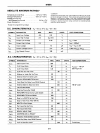
8155/8156/8155-2/8156-2
PROGRAMMING OF THE
COMMAND
REGISTER
The command register consists of eight latches. Four
bits
(0-3) define the mode of the ports. two bits (4-5)
enable
or
disable the interrupt from
port
C when it acts
as
control port. and the last two bits (6-7)
areforthetimer.
The command register contents can be altered at any
time
by
using the
110
address
XXXXXOOO
during a WRITE
operation with the Chip Enable active and lo/fiil =
1.
The
meaning
of
each bit
of
the command byte is defined in
Figure
3.
The contents
of
the command register may
never be read.
765432
0'"
INPUT
DEFINES
PB()'7
1 = OUTPUT
1:=
DEfINESPA
..
, }
OO"'AlT1
1'=ALT2
DEFINES
PC0-5
{
01
=
At
T 3
10
=
AlT
4
'--------_
~::EBRL:U~RT
A
}
,
..
ENABLE
o·
DISABLE
'---
________
~:::;:U~ATB
"-TIMER
COMMAND
00
= NOP -
00
NOT
AFFECT COUNTER
OPERATION
01
=
STOP
-
NOP
If
TIMER HAS NOT STARTED;
STOP COUNTING
IF
THE TIMER
IS
RUNNING
10 =
STOP
AFTER
Te
-
STOP
IMMEDIATELY
AFTER
PRESENT
Te
IS REACHED (NOP
IF TIMER HAS NOT STARTED)
11
= START - LOAD MODE AND CNT LEfI!GTH
AND START IMMEDIATELY AFTER
LOADING
(IF TIMER
IS
NOT
PRESENTLY
RUNNING).
If
TIMER
IS
RUNNING,
START
THE
NEW
MODE AND CNT LENGTH
IMMEDIATELY AFTER PRESENT
Te
IS REACHED.
Figure
3.
Command Register Bit Assignment
6-85
READING THE STATUS REGISTER
The status register consists of seven latches. one
for
each
bit; six
(0-5)
for
the status of the ports and one
(6)
for
the
status of the timer.
The status
of
the timer and the
I/O
sec.tion can be polled
by reading the Status Register (Address
XXXXXOOO).
Status word format is shown
in
Figure
4.
Note that you
may never write to the status register since the command
register shares the same
I/O address and the command
register is
selected when a write
to
that address is issued.
PORT A INTERRUPT REQUEST
PORT A BUFFER FULL/EMPTY
(INPUT/OUTPUT)
PORT A
INTERRUPT ENABLE
PORT B
INTERRUPT ReQUEST
'---------_
PORT B BUFFER FULL/EMPTY
IINPUTIOUTPUT)
'-----------_
PORT B INTERRUPT ENABLED
'--------------
TIMER INTERRUPT (THIS BIT
IS
LATCHED HIGH
WHEN
TERMINAL COUNT
IS
REACHED,
AND
IS
RESET
TO
LOW
UPON
READING OF THE
CIS REGISTER AND
BY
HARDWARE RESET).
Figure
4.
Status Register Bit Assignment


















